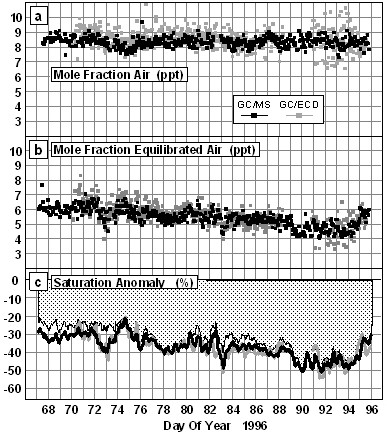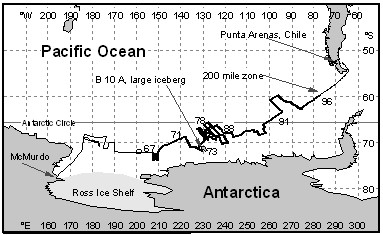

Figure 1. BLAST III cruise track from McMurdo, Antarctica, to Punta Arenas, Chile. Numbers along the cruise track indicate the Julian day of year 1996.
Figure 2. Measurements of methyl bromide in air (a), air equilibrated with surface water (b), and the resulting saturation anomaly (c) for both the GC/MS and the GC/ECD systems. The shaded area in panel (c) represents the saturation anomaly, corrected for physical effects, calculated from the GC/MS saturation anomaly (black line).
Anbar, A.D., Y.L. Yung, and F.P. Chavez, Methyl bromide: Ocean sources, ocean sinks, and climate sensitivity, Glob. Biogeochem. Cycles, 10, 175-190, 1996.
Butler, J.H., J.W. Elkins, T.M. Thompson, and B.D. Hall, Oceanic consumption of CH3CCl3: Implications for tropospheric OH, J. Geophys. Res. 96, 22347-22355, 1991.
Butler, J.H., and J.M. Rodriguez, Methyl bromide in the atmosphere, in The Methyl Bromide Issue, edited by C.H. Bell, N. Price and B. Chakrabarti, pp 27-90, John Wiley & Sons, Chichester, 1996.
Lobert, J.M., J.H. Butler, S.A. Montzka, L.S. Geller, R.C. Myers, and J.W. Elkins, A net sink for atmospheric methyl bromide in the East Pacific Ocean, Science 267, 1002-1005, 1995.
Lobert, J.M., J.H. Butler, L.S. Geller, S.A. Yvon, S.A. Montzka, R.C. Myers, A.D. Clarke, J.W. Elkins, BLAST 94: Bromine Latitudinal Air Sea Transect 1994. Report on oceanic measurements of methyl bromide and other compounds, NOAA Technical Memorandum ERL CMDL-10, 39 pp, Boulder, CO, 1996.
Moore, R.M., and M. Webb, The relationship between methyl bromide and chlorophyll a in high latitude ocean waters, Geophy. Res. Lett., 23, 2951-2954, 1996.
Pilinis, C., D.B. King, and E.S. Saltzman, The oceans
- a source or a sink of methyl bromide?, Geophys. Res. Lett.,
23, 817-820, 1996.
_____________